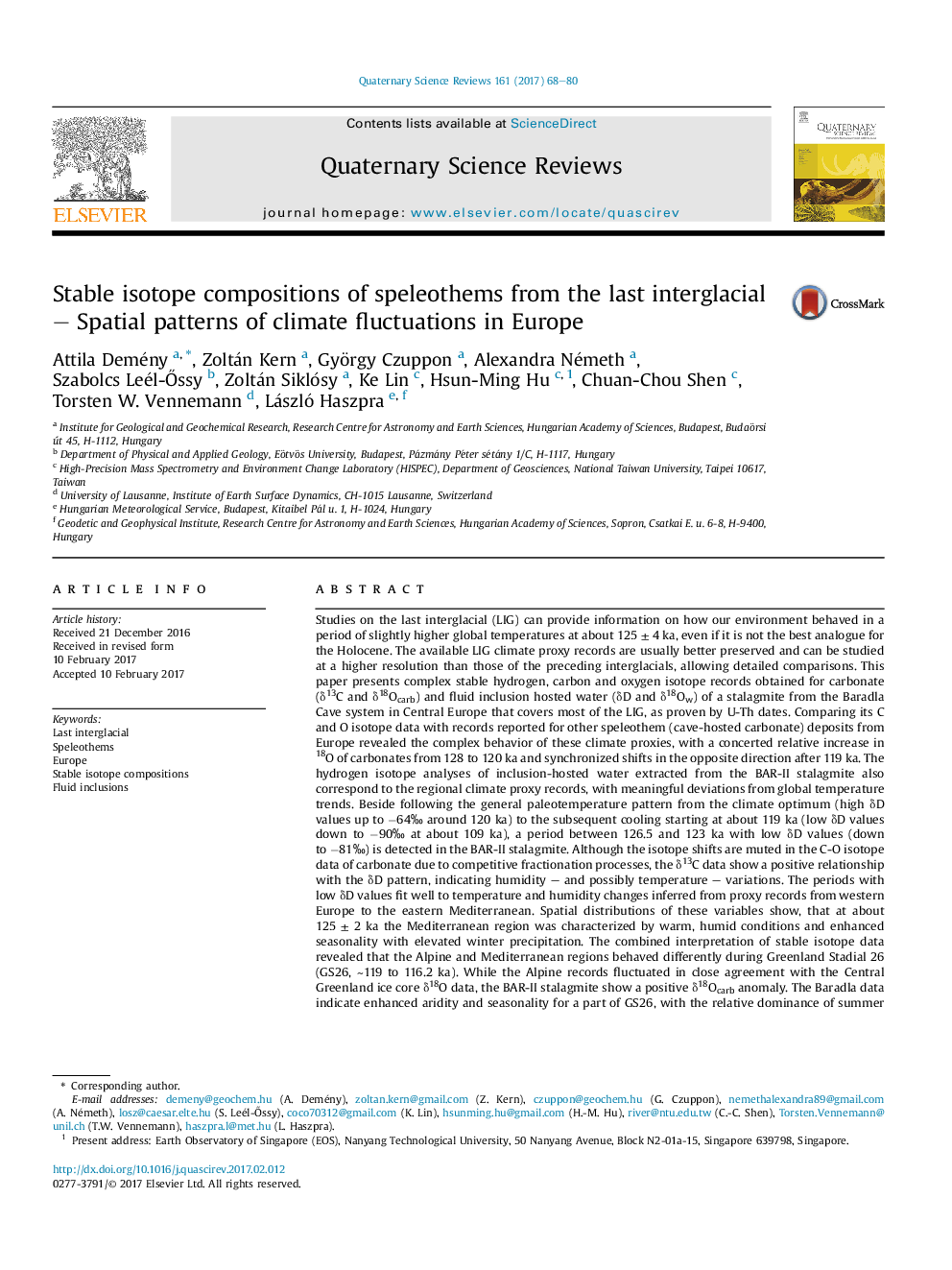| کد مقاله | کد نشریه | سال انتشار | مقاله انگلیسی | نسخه تمام متن |
|---|---|---|---|---|
| 5786701 | 1640774 | 2017 | 13 صفحه PDF | دانلود رایگان |
عنوان انگلیسی مقاله ISI
Stable isotope compositions of speleothems from the last interglacial - Spatial patterns of climate fluctuations in Europe
دانلود مقاله + سفارش ترجمه
دانلود مقاله ISI انگلیسی
رایگان برای ایرانیان
کلمات کلیدی
موضوعات مرتبط
مهندسی و علوم پایه
علوم زمین و سیارات
زمین شناسی
پیش نمایش صفحه اول مقاله

چکیده انگلیسی
Studies on the last interglacial (LIG) can provide information on how our environment behaved in a period of slightly higher global temperatures at about 125 ± 4 ka, even if it is not the best analogue for the Holocene. The available LIG climate proxy records are usually better preserved and can be studied at a higher resolution than those of the preceding interglacials, allowing detailed comparisons. This paper presents complex stable hydrogen, carbon and oxygen isotope records obtained for carbonate (δ13C and δ18Ocarb) and fluid inclusion hosted water (δD and δ18Ow) of a stalagmite from the Baradla Cave system in Central Europe that covers most of the LIG, as proven by U-Th dates. Comparing its C and O isotope data with records reported for other speleothem (cave-hosted carbonate) deposits from Europe revealed the complex behavior of these climate proxies, with a concerted relative increase in 18O of carbonates from 128 to 120 ka and synchronized shifts in the opposite direction after 119 ka. The hydrogen isotope analyses of inclusion-hosted water extracted from the BAR-II stalagmite also correspond to the regional climate proxy records, with meaningful deviations from global temperature trends. Beside following the general paleotemperature pattern from the climate optimum (high δD values up to â64â° around 120 ka) to the subsequent cooling starting at about 119 ka (low δD values down to â90â° at about 109 ka), a period between 126.5 and 123 ka with low δD values (down to â81â°) is detected in the BAR-II stalagmite. Although the isotope shifts are muted in the C-O isotope data of carbonate due to competitive fractionation processes, the δ13C data show a positive relationship with the δD pattern, indicating humidity - and possibly temperature - variations. The periods with low δD values fit well to temperature and humidity changes inferred from proxy records from western Europe to the eastern Mediterranean. Spatial distributions of these variables show, that at about 125 ± 2 ka the Mediterranean region was characterized by warm, humid conditions and enhanced seasonality with elevated winter precipitation. The combined interpretation of stable isotope data revealed that the Alpine and Mediterranean regions behaved differently during Greenland Stadial 26 (GS26, â¼119 to 116.2 ka). While the Alpine records fluctuated in close agreement with the Central Greenland ice core δ18O data, the BAR-II stalagmite show a positive δ18Ocarb anomaly. The Baradla data indicate enhanced aridity and seasonality for a part of GS26, with the relative dominance of summer precipitation and Mediterranean moisture contribution. Following the GS26 event, the effect of long-term global cooling becomes dominant in the Baradla isotope records and leads to glacial inception at about 109 ka.
ناشر
Database: Elsevier - ScienceDirect (ساینس دایرکت)
Journal: Quaternary Science Reviews - Volume 161, 1 April 2017, Pages 68-80
Journal: Quaternary Science Reviews - Volume 161, 1 April 2017, Pages 68-80
نویسندگان
Attila Demény, Zoltán Kern, György Czuppon, Alexandra Németh, Szabolcs Leél-Åssy, Zoltán Siklósy, Ke Lin, Hsun-Ming Hu, Chuan-Chou Shen, Torsten W. Vennemann, László Haszpra,